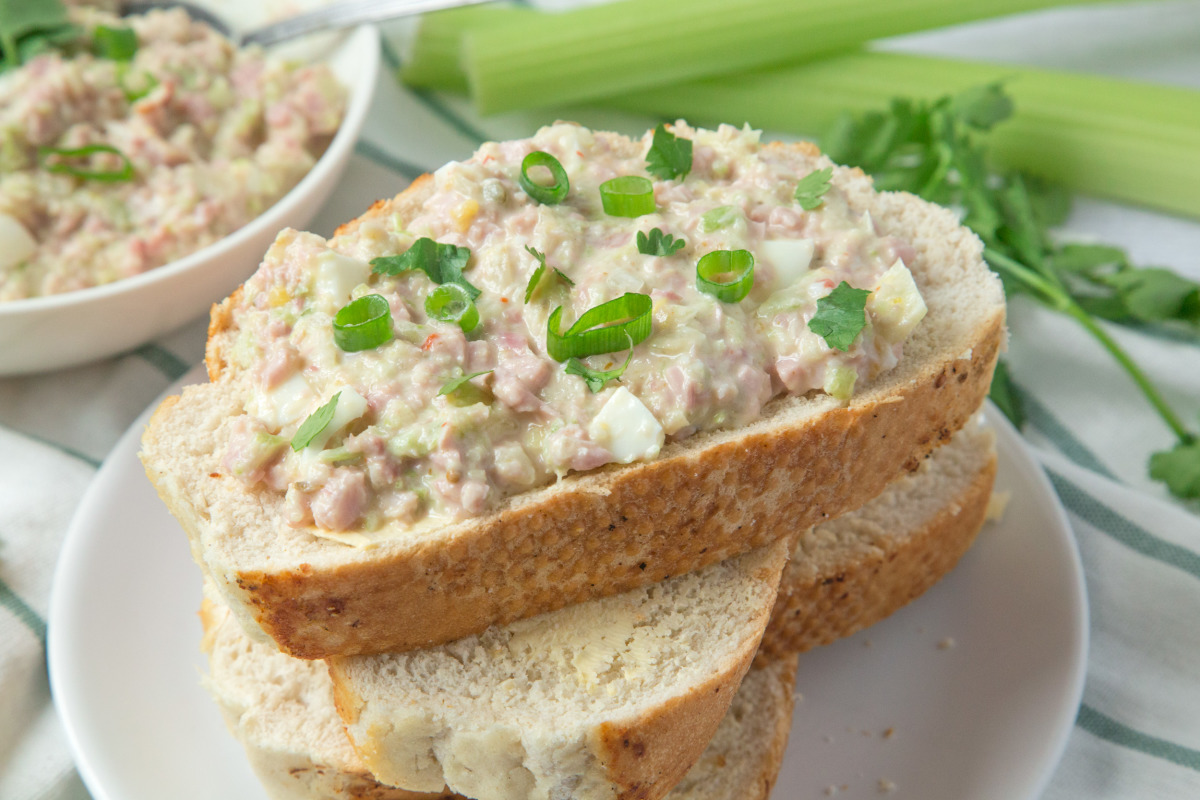Chances are you’ve encountered some version of ham salad before – that humble mix of ground ham, mayonnaise, and pickle relish that graces luncheon plates, sandwiches, and potlucks across America With its no-fuss preparation and familiar flavors, ham salad feels like an eternal fixture of our culinary landscape But where and when did this economical protein salad originate?
Ham salad’s beginnings reach back over a century, intertwined with some key forces the rise of industrial food processing, the post-Civil War proliferation of baked hams, and the call for thrifty home cooking Let’s delve into the history of how ham salad came to be an American staple.
The Dawn of Processed Pork Products
While salting and smoking of pork legs to preserve them had been practiced for ages, the availability of affordable “ready-to-eat” hams expanded in post-Civil War America as meatpacking companies ramped up production and distribution. The war had stimulated demand for portable preserved foods to feed massive armies in the field. Railroads aided shipping dressed pork from Chicago slaughterhouses nationwide. Refrigerated rail cars later enabled safe transport of fresh and cured meats for civilians.
By the late 1800s, hams were among America’s first widely available processed and packaged foods. Sources like Armour & Company flooded general stores with affordable canned and salted hams ready for baking at home.
The Rise of Creative Ham Recipes
As precooked hams grew ubiquitous, home cooks sought creative ways to use up leftovers after the holiday feasting. Nineteenth century cookbooks contain some of the earliest recipes turning baked ham into salads and hashes. For example, Mrs. Porter’s New Southern Cookery Book published in 1871 includes a basic preparation of minced ham blended with vinegar, mustard, and cayenne pepper.
Fanny Lemira Gillette’s White House Cook Book from 1887 instructs chopping cold boiled ham, mixing with hard boiled eggs, vinegar, and spices for “ham salad.” The growing availability of commercial mayonnaise around the early 1900s led most ham salad recipes to ditch the vinegar in favor of mayo for creaminess.
By the early 20th century, ham salad recipes were commonplace in community cookbooks and ladies’ magazines across the Midwest, Mid-Atlantic, and South – regions where pork consumption reigned supreme. Adding pickle relish and celery for crunch became standard practice.
Why Ham Salad Became a Funeral Staple
During the Depression era, thrift and creatively using every morsel of food was essential. Combining affordable ingredients like ham trimmings and mayo into ham salad allowed home cooks to stretch meals affordably.
Ham salad sandwiches also proved convenient, portable mourning food for post-funeral receptions sometimes referred to as “funeral salads” in this context. Serving guests a hearty protein dish was comforting and the ham salad’s inexpensive ingredients helped families hosting funerals to save money during an already costly time.
The association of ham salad with funeral receptions became so ingrained that by the mid-20th century, some Americans only encountered the lunchmeat salad in this solemn setting. Despite its gloomy connotations, its familiarity still evoked nostalgia.
Ham Salad’s Lasting Appeal and Versatility
While the salad may have originated from humble thrift, its appeal has endured over generations for good reasons. The soft, creamy texture with salty, smoky ham flavor satisfies cravings. It requires just a few affordable ingredients and minutes of hands-off preparation. It can be whipped up with leftovers or convenient canned ham.
Beyond sandwiches, cooks have incorporated ham salad into everything from biscuit pockets, deviled eggs, and lettuce wraps to pasta and potato salads for a protein punch. Customize your batch with any extra vegetables or spices on hand. For an easy appetizer, form the spread into bite-size balls and coat with chopped pecans.
From its early roots as a homely leftover transformer to an enduring presence at family reunions and church potlucks today, humble ham salad deserves appreciation as a thrifty American classic. With an open mind to trying inventive variations, its simplicity may just get elevated to new taste heights. Any recipe that has survived more than a century must have some powerful appeal worth savoring.
So next time you spy that familiar bowl of ham salad at a gathering, appreciate each bite as a bite of history. Just maybe steer clear of the funeral reception servings!

Old Fashioned Ham Salad Spread
When was Ham Salad invented?
Ham salad originated in the 1920s when people would make it for their own sandwiches at home. Vintage ham salad recipes popular and were originally used as an economical way to use leftover ham from holiday meals. What’s in ham spread?
Where is ham salad popular?
Ham salad is popular in the Upper Midwest, Mid-Atlantic and Southeastern regions of the United States, which have long histories of pork and ham production. ^ Bauer, Elise (6 June 2010).
What is a ham salad?
Ham salad generally includes cooked or canned cold ham which has been minced, cubed, or ground; the mayonnaise or other dressing; diced sour or sweet cucumber pickles or cucumber pickle relish; and perhaps chopped raw celery, green pepper, or onion. Raw cucumber, shredded carrot, pimento, sweet corn kernels, or tomato are sometimes used.
What is ham salad & ham spread?
Ham salad and ham spread usually describe the same recipe of finely chopped ham mixed with mayo and a few other ingredients to make a delicious afternoon snack! You can use any kind of cooked ham that you like. This recipe is a great way to repurpose leftover ham and it doesn’t matter what glaze you put on your ham, it always turns out perfect!
